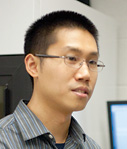One research project will use brain activity to forecast the success of large-scale health campaigns. Another involves making artificial platelets from the ground up, and turning synthetic biology upside down in the process.
These projects earned two U-M scientists — Emily Falk and Allen Liu — the 2012 National Institutes of Health Director’s New Innovator Award.

Falk
Falk, an assistant professor of communication studies and psychology, LSA, and faculty associate at the Institute for Social Research, and Liu, an assistant professor of mechanical engineering, were officially announced as recipients Sept. 13 at the organization’s symposium.
The U-M faculty were among 51 researchers to get the award, which was established in 2007. It supports investigators who are within 10 years of their terminal degree or clinical residency, but who have not yet received a Research Project Grant (R01) or equivalent NIH grant, to conduct exceptionally innovative research.
This prestigious honor, which awards up to $1.5 million for five years, stimulates innovative research and supports promising new investigators.
Falk said her goal is to design communications that improve population health. Poor diet, lack of exercise, and tobacco and alcohol consumption are leading causes of morbidity and mortality, both in the United States and throughout the developed world. Falk’s lab has found that the brain can predict behaviors better than people’s own intentions. She now will use neuroscience methods to improve the design and selection of large-scale health campaigns targeting these kinds of behaviors.
The lab’s research will identify the neural patterns triggered by health campaigns that are successful at changing people’s behavior and will use these maps to forecast the success of new campaigns before they are launched. People are notoriously bad at knowing what will persuade them, but the brain may be able to pick out winning messages much more accurately than has been possible in the past. This could ultimately lead to less cancer, heart disease, and other chronic conditions.
“Mass communication has profound effects on society — the next five years will unlock new insights about how we can maximize the impact of health campaigns,” Falk said. “This honor validates our lab’s core mission.”

Liu
Liu intends to make artificial platelets out of biological components that come together in a new way. Platelets are blood components that trigger clots and stop bleeding. They’re chronically in short supply at blood banks because they don’t stay fresh for more than a few days at room temperature and can’t be refrigerated. The chill induces clotting. Platelet transfusions are common treatments for patients with low levels, such as those with cancer, heavy bleeding or certain autoimmune diseases. Injured soldiers might especially benefit from a long-lasting artificial version, Liu said.
To make the platelets, Liu intends first to develop a layered film that incorporates components from bacteria, human cells and synthetic molecules. He’ll pinch it into tiny spheres with an instrument that, like blowing bubbles, pulses fluid at the film through a pipette until closed vesicles form.
It’s the rare synthetic biologist who takes this bottom-up approach, building biological machines one block at a time, Liu said. Researchers more often harness a full system such as a bacterium and re-engineer it to make a new byproduct such as a biofuel or pharmaceutical product.
“The artificial platelet is an application of the idea of doing synthetic biology from the bottom up,” Liu said. “We’re at the very primitive stages of thinking about the field in this way. Ideally, what I’d like to do is build on this platform and figure out how you can communicate a stimulus from the external environment to inside the artificial cell to trigger a response, very much like in the engineering world where you have sensors and actuators.”
Liu is quick to point out that this won’t be easy.
“It’s a crazy idea,” he said. “There’s a 95 percent chance we’ll fail. But if we succeed, the possibilities are infinite. That’s the beauty of this grant.”

